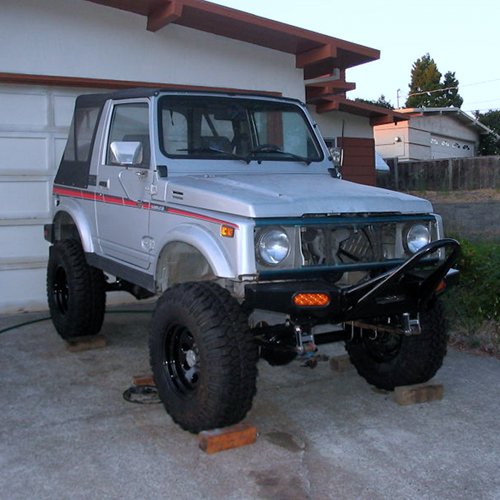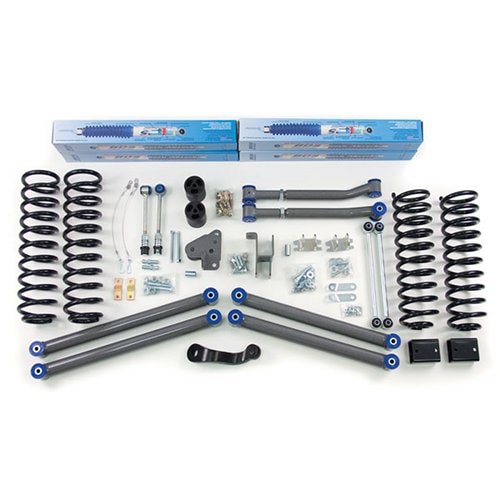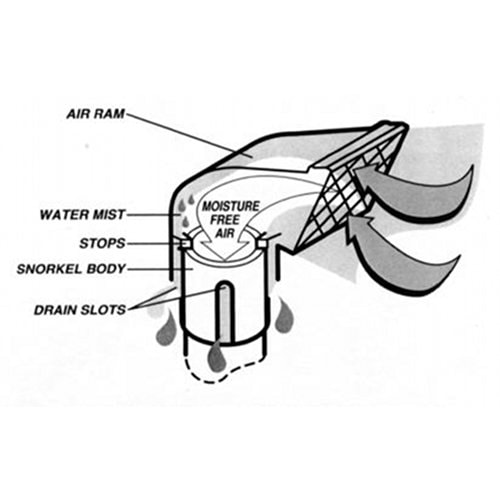If you’re the type of guy or gal that loves the nature but doesn’t have the will power to leave the car at home and go kicking, than off-roading might be your game. This hobby may look expensive, as the first thing you need is an all-wheel-drive car.
The good news is that off-roading does not require an expensive car. Your beloved vehicle will have to face mud, water, tree-branch scratches, bumps and dents, so it is recommended that you start with a small, cheap but capable car, like a Suzuki Samurai or Jimny, a Jeep Wrangler, an old Toyota Landcruiser or whatever you might find that fits this profile.
After getting the car and making sure that everything works, you should consider buying a lifting kit. A lift kit is an aftermarket vehicle modification that lifts either the suspension or the body to give the vehicle a higher profile. Installing a lifting kit will allow bigger tires to be installed, as the wheel wells ride higher. There are two kinds of lifting kits: body lifts and suspension lifts, each having advantages and disadvantages.
The body lift will only lift the body from the frame, so you won’t get better ground clearance, but you will be able to user bigger tires. This is an inexpensive alternative which consists of blocks or spacers. Depending on the type of vehicle you chose, additional cash might be spent on modifications needed when installing a body lift: extending the gearshift through the floorboard or raising the bumpers. As it does not increase travel or improve the suspension, this is not the lift of choice for off-roaders.
The other alternative is a suspension lift. Your car will ride higher, as installing a suspension lift replaces the springs and shocks. The vehicle gets greater travel, better ground clearance, improved articulations and allows the use of taller tires. When installing a suspension lift the steering geometry is almost always affected, so you should consider adding steering stabilizers to the shopping cart. Suspension lifts usually offer a 4-inch (10.16 cm) or 6-inch (15.24 cm) lift, but extreme ones can go up to 18 inches (45.72 cm).
When deciding how much taller you want your car to be, you need to take into consideration some important aspects. First of all, keep in mind that the higher you rise your vehicle, the higher its center of gravity will be; and the higher the center of gravity is, the less stable the car gets at high speed or in tight turns. After installing taller tires, your speedometer and odometer will both be off, unless modifications are made that take into account the new tires’ circumference.
Another important modification your vehicle should get for off-road driving is a snorkel, which is a relocated air intake. Driving any car in extreme conditions makes its factory air intake susceptible to water, dirt and dust, especially as it is usually located in the engine bay. So installing a snorkel will provide your car with the fresh air it needs to run.
You should know that each snorkel is designed for its specific vehicle. So you’ll have to find the model that fits your car. The good news is that there are a lot of snorkel manufacturers out there, so finding one to fit your budget should not be a problem. Installing a snorkel is quite straightforward and simple. The hardest part should be cutting into your fender, so if you’re not a mechanic you should leave the job to the pros. There’s the possibility you’ll seriously damage your car.
If you’re going to hit muddy, extreme roads, you must consider installing a winch, as it will help you get out of the most sticky situations. The winch is a mechanical device mounted on the front of the vehicle, and sometimes on the back, that’s used to pull the vehicle when it no longer has any grip.
The winch can be hydraulic or electric, but most of the ones meant for off-roading are electric. Winches have different powers, so you should choose your model by taking into consideration your car’s weight.
Let’s consider a car weighing 1.75 tonnes, which will have a gross weight of 2.5 tonnes. Multiply the gross weight by 1.5 and you get 3.75 tonnes, which is about 8,500 lbs. It is recommended that you get a slightly bigger winch than you need, so a 9,500 lbs winch would be ideal.
When fitting a winch, you might also need to buy a special winch bumper. The installation is quite complicated, so if you’re not a mechanic, you should go to a garage, especially since there’s welding involved. Keep in mind that for using the winch you’ll need a pair of thick leather gloves as its steel cable tends to have splitters, a tree strop to connect your winch cable to and shackles to connect all the accessories together. Happy off-roading!
The good news is that off-roading does not require an expensive car. Your beloved vehicle will have to face mud, water, tree-branch scratches, bumps and dents, so it is recommended that you start with a small, cheap but capable car, like a Suzuki Samurai or Jimny, a Jeep Wrangler, an old Toyota Landcruiser or whatever you might find that fits this profile.
After getting the car and making sure that everything works, you should consider buying a lifting kit. A lift kit is an aftermarket vehicle modification that lifts either the suspension or the body to give the vehicle a higher profile. Installing a lifting kit will allow bigger tires to be installed, as the wheel wells ride higher. There are two kinds of lifting kits: body lifts and suspension lifts, each having advantages and disadvantages.
The body lift will only lift the body from the frame, so you won’t get better ground clearance, but you will be able to user bigger tires. This is an inexpensive alternative which consists of blocks or spacers. Depending on the type of vehicle you chose, additional cash might be spent on modifications needed when installing a body lift: extending the gearshift through the floorboard or raising the bumpers. As it does not increase travel or improve the suspension, this is not the lift of choice for off-roaders.
The other alternative is a suspension lift. Your car will ride higher, as installing a suspension lift replaces the springs and shocks. The vehicle gets greater travel, better ground clearance, improved articulations and allows the use of taller tires. When installing a suspension lift the steering geometry is almost always affected, so you should consider adding steering stabilizers to the shopping cart. Suspension lifts usually offer a 4-inch (10.16 cm) or 6-inch (15.24 cm) lift, but extreme ones can go up to 18 inches (45.72 cm).
When deciding how much taller you want your car to be, you need to take into consideration some important aspects. First of all, keep in mind that the higher you rise your vehicle, the higher its center of gravity will be; and the higher the center of gravity is, the less stable the car gets at high speed or in tight turns. After installing taller tires, your speedometer and odometer will both be off, unless modifications are made that take into account the new tires’ circumference.
Another important modification your vehicle should get for off-road driving is a snorkel, which is a relocated air intake. Driving any car in extreme conditions makes its factory air intake susceptible to water, dirt and dust, especially as it is usually located in the engine bay. So installing a snorkel will provide your car with the fresh air it needs to run.
You should know that each snorkel is designed for its specific vehicle. So you’ll have to find the model that fits your car. The good news is that there are a lot of snorkel manufacturers out there, so finding one to fit your budget should not be a problem. Installing a snorkel is quite straightforward and simple. The hardest part should be cutting into your fender, so if you’re not a mechanic you should leave the job to the pros. There’s the possibility you’ll seriously damage your car.
If you’re going to hit muddy, extreme roads, you must consider installing a winch, as it will help you get out of the most sticky situations. The winch is a mechanical device mounted on the front of the vehicle, and sometimes on the back, that’s used to pull the vehicle when it no longer has any grip.
The winch can be hydraulic or electric, but most of the ones meant for off-roading are electric. Winches have different powers, so you should choose your model by taking into consideration your car’s weight.
Let’s consider a car weighing 1.75 tonnes, which will have a gross weight of 2.5 tonnes. Multiply the gross weight by 1.5 and you get 3.75 tonnes, which is about 8,500 lbs. It is recommended that you get a slightly bigger winch than you need, so a 9,500 lbs winch would be ideal.
When fitting a winch, you might also need to buy a special winch bumper. The installation is quite complicated, so if you’re not a mechanic, you should go to a garage, especially since there’s welding involved. Keep in mind that for using the winch you’ll need a pair of thick leather gloves as its steel cable tends to have splitters, a tree strop to connect your winch cable to and shackles to connect all the accessories together. Happy off-roading!









